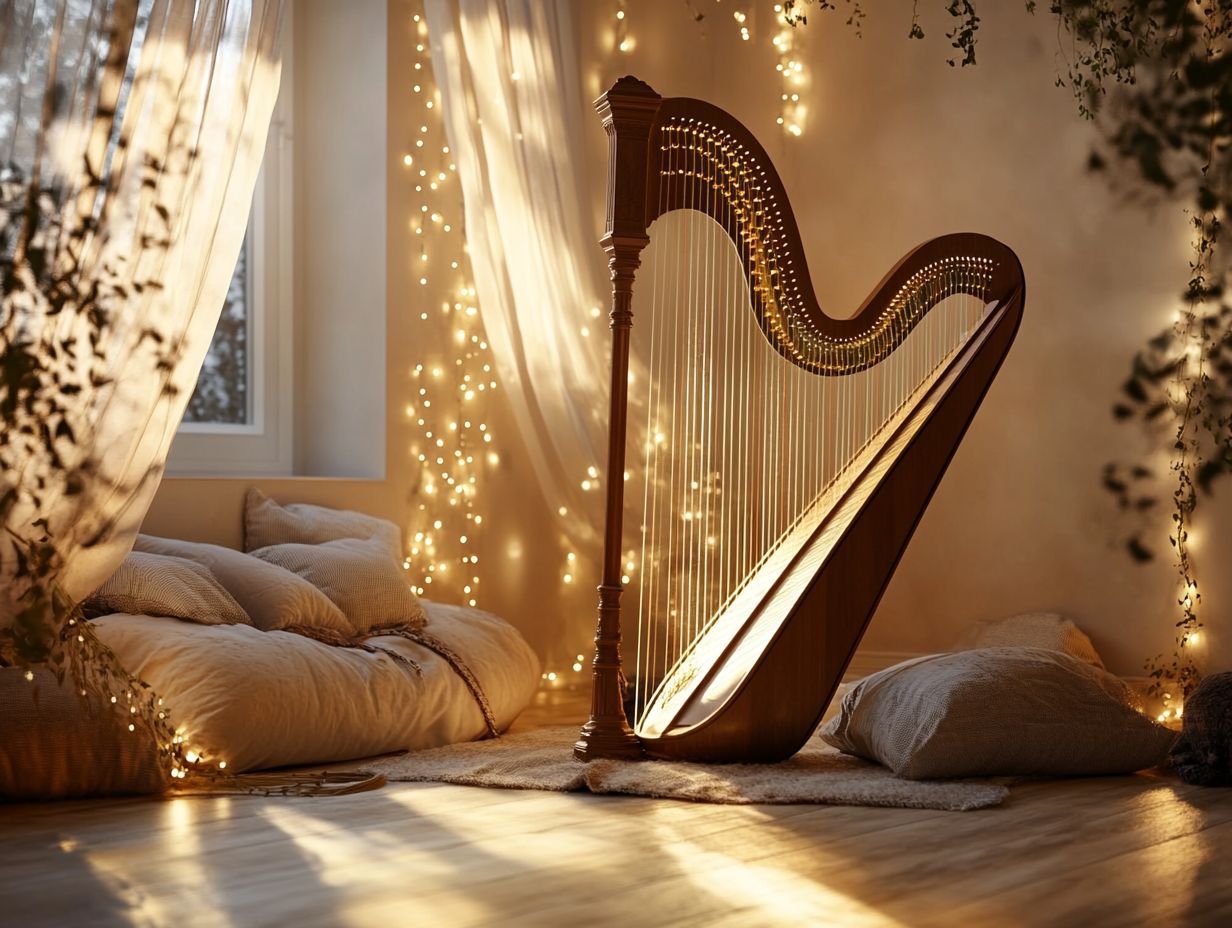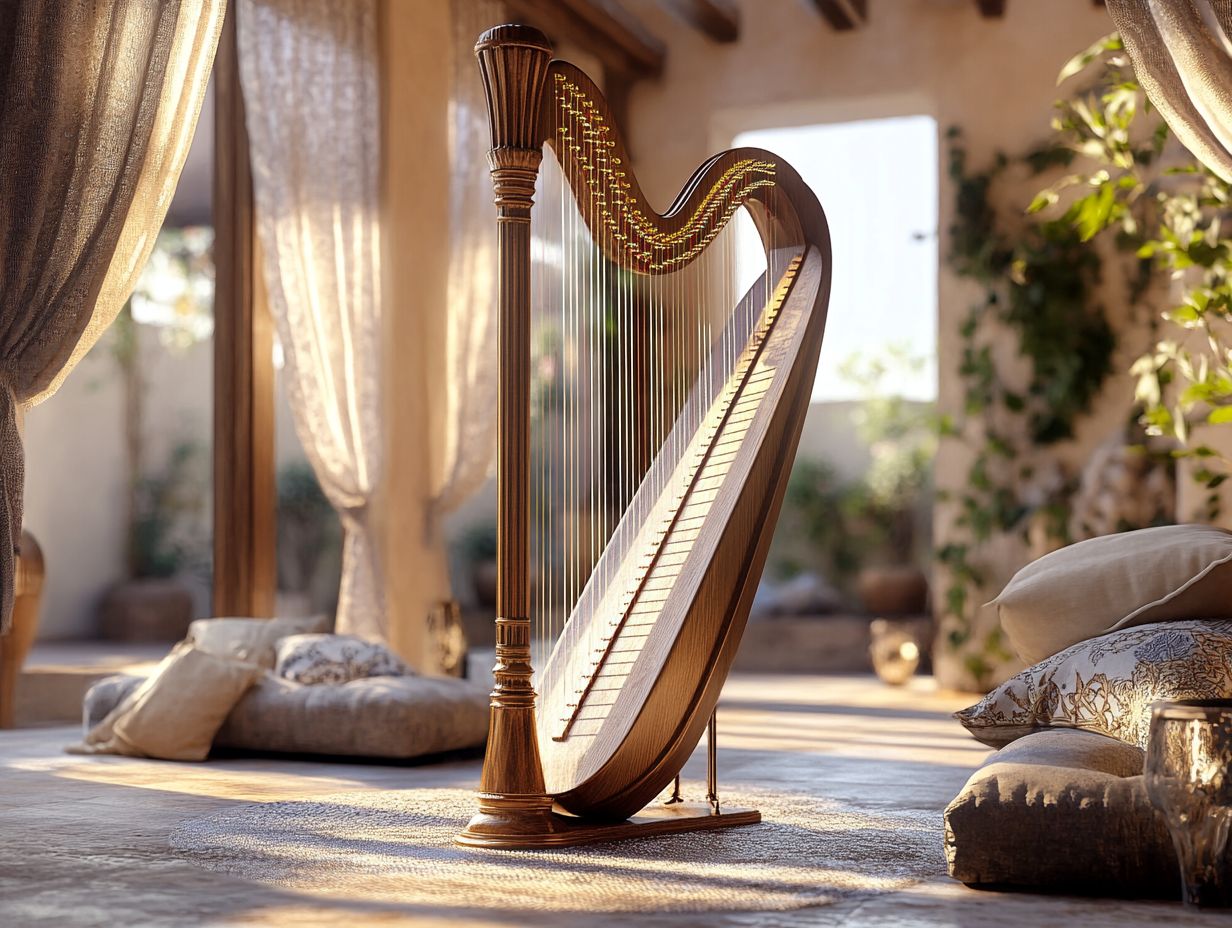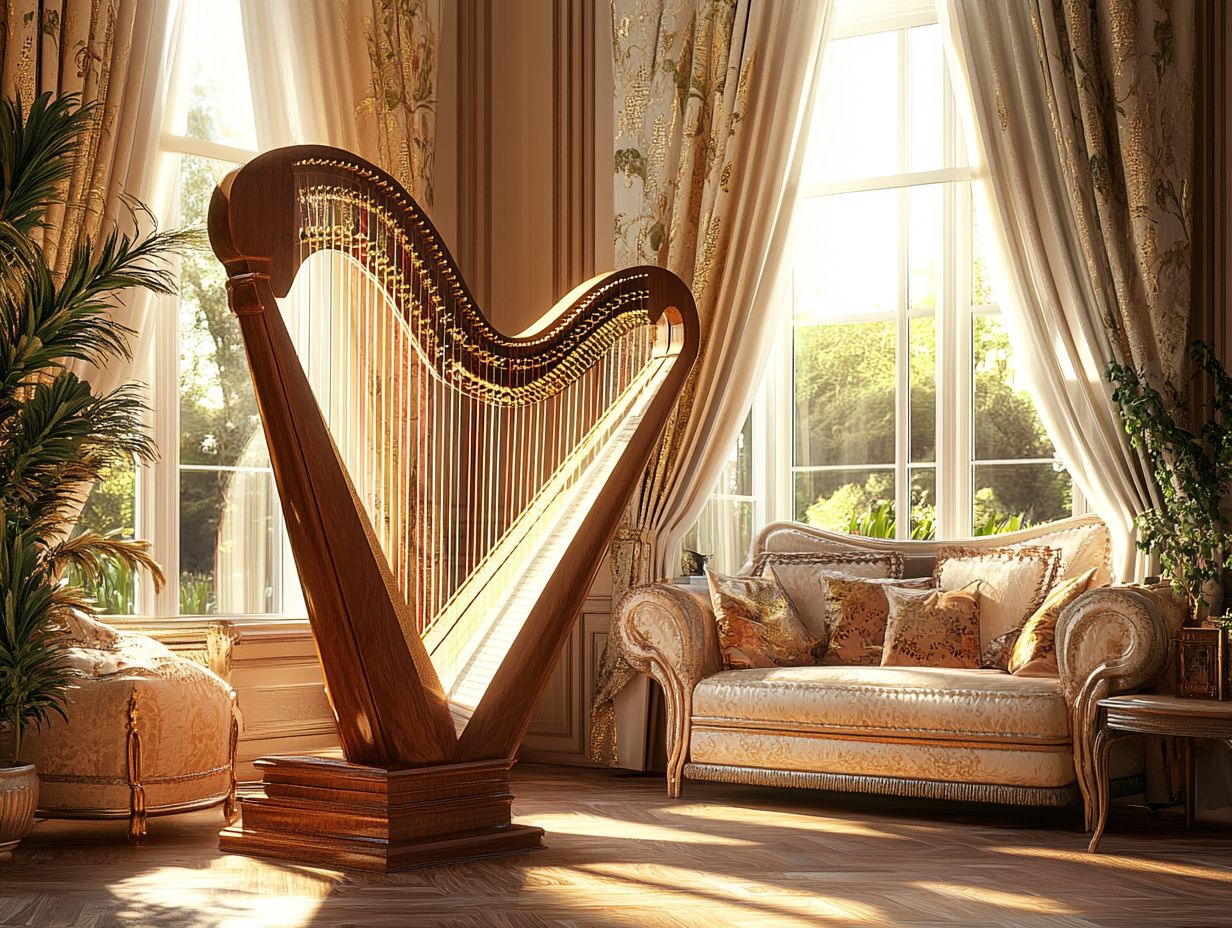The harp, renowned for its ethereal sound and rich history, has captivated hearts across cultures and centuries.
This article delves into the origins and evolution of this enchanting instrument, emphasizing its significance in diverse traditions.
We will explore the anatomy of the harp, uncovering the unique qualities that contribute to its heavenly sound. Discover various playing techniques, celebrate the achievements of famous harpists, and examine the harp’s representation in popular culture.
Furthermore, learn about the numerous benefits of playing this beautiful instrument for both the body and mind. Join us on this journey through the world of the harp, where every note tells a story.
Contents
The History of the Harp

The history of the harp narrates its journey to becoming a significant part of music around the world, highlighting its origins, evolution, and eventual prominence across various societies. This string instrument traces its roots back to ancient civilizations and has undergone transformations in design and technique over the centuries.
The harp has ultimately come to symbolize heavenly sound and emotional expression within both classical and folk music traditions. Its exquisite craftsmanship and artistry have enabled it to resonate profoundly with audiences, forging harmonious connections that transcend both time and geography.
Origins and Evolution
The harp is believed to have originated in the Nile Valley or possibly even earlier in Mesopotamia and Egypt, where it became a symbol of spirituality and the arts by the 3rd millennium BC.
This instrument has been adapted by various cultures over time and has undergone significant transformations throughout history. In ancient cultures, ranging from the Greeks to the Celts, the harp was more than just a musical instrument; it played a vital role in storytelling and social gatherings.
Its design varied according to the era and location, evolving from the iconic triangular shape to more elaborate forms, influenced by the materials and craftsmanship of instrument makers. Historical events, such as the rise and fall of empires, helped spread the harp’s popularity across continents, ensuring that its beautiful sounds continued to resonate through the ages.
Significance in Different Cultures
The harp has held significant cultural importance in various societies, symbolizing themes of harmony, peace, and the expression of deep emotions through its melodic music. This exquisite instrument has been integral to many cultures, from the ceremonial music of Celtic communities to the storytelling traditions of ancient peoples.
The resonance of the harp is often associated with the spiritual realm, as it is played during rituals and significant life events, underscoring the connection between music and the human experience. Its role in folk music traditions showcases a diverse array of stories, allowing musicians to convey their narratives of love, loss, and celebration through the instrument’s gentle sound.
Additionally, the skill required to play the harp adds a further dimension to its significance, captivating audiences and preserving the art of storytelling across generations.
The Anatomy of a Harp

The anatomy of a harp consists of various components that contribute to its unique sound quality and performance characteristics. These components include the soundboard, neck, body, undercarriage, strings, and pedals.
The design of the harp showcases the intricate craftsmanship involved in its construction. Each part plays a crucial role in producing the sound waves that create the harp’s characteristic ethereal tone.
Understanding the components of harp anatomy not only enhances appreciation for the instrument but also informs players about the significance of technique and maintenance in achieving optimal sound quality.
Parts and Functions
The harp consists of several key components: the body, neck, strings, and pedals, each of which plays a vital role in producing the instrument’s unique sound and beauty.
The body serves as a resonating chamber and is typically crafted from high-quality woods such as maple or cherry, which amplify the sound of the vibrating strings when they are plucked. The neck connects the body to the head, providing structural stability while maintaining the proper tension on the strings.
Each string is made from various materials, including gut, nylon, or metal, and produces a distinct pitch that influences the tonal quality of the instrument. The pedals, which can be adjusted by the harpist’s feet, raise or lower the pitch of the strings, adding versatility to their performances.
The craftsmanship involved in assembling these components greatly enhances the sound and playability of the harp, ensuring that each instrument delivers a high-quality musical experience.
The Heavenly Sound of the Harp
The harp’s heavenly sound is characterized by its ethereal quality and rich resonance, making it one of the most cherished string instruments in both classical and contemporary music.
Through a delicate interplay of acoustic design and skilled playing techniques, the harp produces melodic lines that evoke a sense of tranquility and emotional depth.
Its ability to create diverse soundscapes enhances its popularity in therapeutic settings, as well as in performances designed to inspire and connect with audiences.
Unique Qualities and Characteristics

The harp possesses unique qualities due to its construction, which affords it a broad dynamic and tonal range, as well as its ability to produce sound waves that resonate beautifully in any environment. This versatility distinguishes it from other string instruments, enabling it to convey a wide spectrum of emotions, from tranquility to joy.
The harp’s capacity to produce soft and delicate sounds fosters a powerful emotional connection between musicians and their listeners. Its soothing and comforting tones have a remarkable ability to provide solace and healing, whether in concert halls, quiet rooms, or therapeutic sessions.
The harp’s extensive tonal range invites listeners into a rich auditory experience, enhancing emotional expression and making it a valued instrument in both performance and healing contexts.
Playing the Harp
Playing the harp demands a blend of techniques and styles that showcase both the instrument’s versatility and the artistry of the performer. From the gentle plucking of strings to intricate fingerpicking patterns, each technique allows the musician to convey a wide range of emotions, resulting in captivating performances that engage audiences and foster a deep connection with the music.
Additionally, the ability to improvise adds another layer of creativity, enabling harpists to explore spontaneous soundscapes that can evoke feelings of nostalgia and inspiration.
Techniques and Styles
Harp techniques and styles vary significantly, ranging from classical fingerpicking to contemporary strumming, each offering a unique approach to music that highlights the instrument’s versatility.
The subtlety of fingerpicking in classical pieces, such as Debussy’s “Clair de Lune,” emphasizes the harp’s ethereal sound, allowing each note to shimmer and resonate.
In contrast, the vibrant strumming technique commonly found in folk and pop genres adds a rhythmic pulse that can energize an audience.
For example, a modern interpretation of a traditional Celtic tune may incorporate both techniques, creating an engaging performance that balances serene melodies with lively beats.
Additionally, techniques like glissando can enhance the expressiveness of a piece, effectively connecting different performance styles and drawing listeners into the emotional landscape of the music.
Famous Harpists

Renowned harpists have significantly contributed to music by demonstrating the harp’s versatility and emotive power through their performances and compositions. Artists like Emily Hopkins and Yolanda Kondonassis have excelled in classical settings while also pushing the boundaries of harp music by incorporating innovative elements and improvisation into their unique styles.
Their dedication and artistry have inspired many musicians and captivated audiences, ultimately elevating the profile of the harp within music culture.
Notable Performers and Their Contributions
Notable harpists such as Harpo Marx and Ruth Inglefield have made significant contributions to the music world, leaving an indelible mark through their unique interpretations of harp music. Their performances have not only highlighted the harp’s versatility but have also expanded its appeal across various musical genres, including classical, contemporary, and pop.
For example, Marx’s playful yet sophisticated style resonated deeply with audiences, revolutionizing the perception of the harp in entertainment. Inglefield, on the other hand, has utilized the instrument to delve into intricate melodies, transforming traditional folk tunes into modern masterpieces.
Together, these artists have elevated the harp to a prominent status, inspiring a new generation of musicians eager to push the boundaries of this enchanting instrument.
The Harp in Popular Culture
The harp is prominently featured in popular culture across various musical genres, artworks, and literary works, highlighting its versatility and emotive power to a broad audience.
From movie soundtracks to contemporary music genres, the ethereal sound of the harp evokes feelings of nostalgia and beauty, bridging the gap between tradition and modernity.
Its representation in both art and literature further underscores the cultural significance of the harp, symbolizing creativity, spirituality, and emotional connection.
Representation in Music, Art, and Literature
The harp holds a prominent place in music, art, and literature, often associated with beauty, peace, and emotion, which makes it a favored subject for artists and composers alike.
Over the centuries, the harp has been celebrated and memorialized in various musical compositions, such as Debussy’s enchanting “Danse Macabre”, which captivates listeners with its tender melodies.
In the realm of literature, the harp is immortalized in poems like Alfred Lord Tennyson’s “The Lady of Shalott”, where the titular character expresses her love for a knight through the music she creates on her harp.
Artistically, the harp frequently appears in paintings by John William Waterhouse, which highlight its connection to the muses and inspiration. Harp music often evokes feelings of nostalgia and tranquility.
This diverse representation underscores the cultural significance of the harp, which is much more than just an instrument.
Benefits of Playing the Harp
Playing the harp offers numerous benefits, including its use as a therapeutic tool that promotes relaxation, mindfulness, and emotional expression.
This instrument is widely favored in therapeutic practices due to its ability to enhance in-depth treatment and rehabilitation for various issues, such as stress relief, emotional discharge, and social integration.
The harp contributes to numerous physical and mental health benefits, including the development of fine motor skills, musical abilities, emotional expression, cognitive skills, and social skills.
Supporting these aspects of overall well-being and balance is a primary purpose of utilizing the harp in therapy settings.
Physical and Mental Health Benefits
The health benefits of playing the harp include enhanced physical dexterity and a remarkable ability to relieve mental stress through its soothing qualities. Playing the harp improves fine motor skills and hand-eye coordination while offering a unique pathway to mindfulness and therapeutic relief.
As players immerse themselves in rhythmic patterns and melodies, their stress levels significantly decrease, creating a calmer mental space. Additionally, playing the harp fosters emotional strength, as the instrument’s expressive quality allows individuals to connect with their emotions.
Engaging in music-making promotes focus and mindfulness, both of which are essential for emotional and personal growth.
